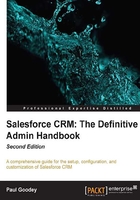
Chapter 2. User Management in Salesforce CRM
In the previous chapter, we looked at user authentication and how user login access is authorized by the Salesforce application. We were introduced to the concept of a user being assigned a profile that could be set to control certain permissions. The user profile login permissions we looked at were restrictions on login hours and IP addresses, which allow you to control when and from where users log in to the Salesforce application.
In this chapter, we will look at how users can be managed in more detail and understand how some of the key profile settings are used within the Salesforce CRM application.
We will start to look into the ways in which a user's profile controls both access to objects and also governs what features are available to that user.
Generally speaking, objects represent database tables that contain your organization's information and are discussed in detail in Chapter 3, Configuration in Salesforce CRM. For example, one of the key objects in the Salesforce CRM application represents account information.
Along with profiles, this chapter also begins to look at the concept of record sharing and provides a high-level look at sharing features within Salesforce. It also describes how these features control access to records for users.
The term record describes a particular occurrence of an object. A specific record could be "American Express" or "Google" that is represented by an account object in our preceding example. We will now look at the following:
- Introduction to record ownership, profiles, and sharing
- Managing users in Salesforce